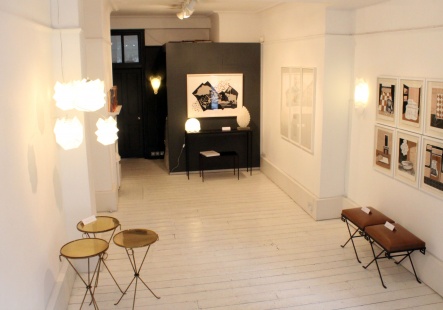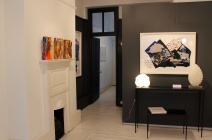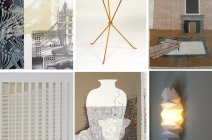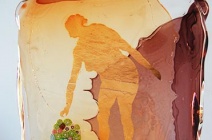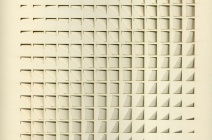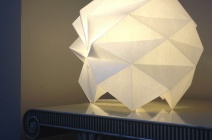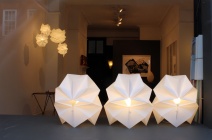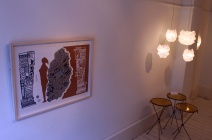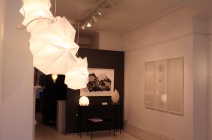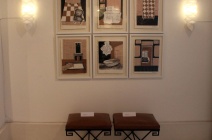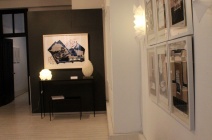By Chance or Design
By Chance or Design
Art and design come together in this show with 1930's classics by iconic French designer Jean-Michel Frank and geometrical lamps by Gilles Espic, in a dialogue with elegant works by artists Toni Davey, Charlotte Hodes and Jane Goodwin. This show is purposely chosen to coincide with London Design Week.
Toni Davey’s white works are concerned with conveying the illusion of three dimensions onto a two dimensional surface. Her elegant cut outs aim to understand this transition through very controlled drawing or by physically reinventing the surface. In the work the underlying structure of the grid is always present. The grid offers the means to retrace one's footsteps and understand the journey, and to allow forms to follow a rule or sequence of changes. All the cut pieces are made from a single sheet of paper with nothing added or taken away.
'To draw, to cut, to score, to fold, two dimensions into three; manipulating light and shadow the surface evolves'.
A magnificent dialogue is established between Toni’s white cut out works and Gilles Espic’s DNA lights. Also using a single sheet of parchment, folding it and overlapping, these origami structures unfold creating wonderful contemporary lighting. The same light can be a table piece or a ceiling lamp, opening up to different shapes and uses. Origamis are based on geometrical patterns that can go very far, and have been studied by architects such as Marcel Breuer. Another set of lights take a more figurative direction, creating "Masks", inspired by Japanese, African or antique masks, designed with geometrical figures.
As if life pre-destined his creative career at birth, Gilles Espic was born in an avant-garde block of apartments with interiors conceived and completed in Marseille by Le Corbusier. Having worked in graphic design in 1993, Gilles began to design lighting. His models were published by renowned Italian producers including Artemide, Italiana Luce and Driade.
Dr. Stephane Boudin-Lestienne, historian and curator of the Villa Noailles describes Gilles’ work: “His origamis in parchment are both evident as to inspiration and yet seem to come from nowhere. One is struck by their architectural or totemic allure though they remain an abstraction outside of such references… The designer has chosen to use his material in its natural state – immaculate parchment that diffuses light so elegantly… Be reassured, when one of his works is lit, one suddenly understands the true ambition of Gilles Espic, his own way of bringing poetry into the world: the folding of light itself.”
Jane Goodwin’s collaged works on paper are a continuation of her previous sculptures and drawings in which she incorporates cuttings from the Financial Times to highlight her continuing interest in the world of high finance.
She is drawn into the multi-faceted reality of “life in the city” and has moved from the corporate office to the high flyers domestic world, in which she explores seemingly tranquil interiors with their high ceilings, and grand open spaces, devoid of any human presence.
The exhibition will showcase iconic furniture pieces by Jean-Michel Frank, the renowned French interior designer known for his minimalist interiors decorated with plain-lined but sumptuous furniture made of luxury materials, such as shagreen, mica, and intricate straw marquetry. In 1920’s Paris, Frank turned his back on the curves and embellishments of Art Nouveau and Art Deco and allied the linear proportions of late eighteenth-century to a twentieth century perception, paring down superfluous detail to the essence of classic modernism. In order that nothing distracted from the elegance of such concept, Frank insisted on sparsely furnished interiors and the perfect finish of walls, denuded of floral moldings, their plaster polished to a pale sheen or paneled in vellum or fine woods. He eliminated excessive furnishings and accentuated the sense of quiet luxury. Frank moved to Buenos Aires and with Ignacio Pirovano, the creator of COMTE in Argentina, they designed and produced the most elegant furniture pieces. He designed the interiors of the houses of the Argentinean elite, hotels and public buildings. A pair of bronze Gueridons circa 1932 and a console table of elegant proportions in iron and leather are amongst the pieces exhibited.
Charlotte Hodes’s papercuts were made in response to the influential book 'The Grammar of Ornament' by Owen Jones published in 1856 in which he laid out his General Principles in thirty seven propositions governing the use of design and ornament in architecture. Hodes has liberally interpreted these 'rules' to create a series of intricate papercuts in which the female figure is seen to move through a world of decoration and pattern. This work develops Hodes' long standing involvement in the relationship between Fine Art, Decoration and the Female Figure and in the way that the female figure has traditionally been depicted as both a decorative and domestic goddess.
Also on show will be glass works made at the renowned glass workshop Berengo Studio, Murano, Venice. Working closely with the master craftsmen they are created using fluid hot glass into which the female figure, hand cut in silver leaf is embedded into the molten glass.
Charlotte’s work builds upon her prize winning work on paper for the Jerwood Drawing Prize in 2006, her solo exhibition at The Wallace Collection 2007, her participation in Glasstress: White Light White Heat exhibitions at both the Venice Biennial 2013 and The Wallace Collection 2013 and in the UK in pop up exhibitions curated by Janice Blackburn OBE. Charlotte has been once again nominated for the Jerwood Prize in 2014.

